Send Email in JavaScript from Windows Store Apps - UWP - HTML5 - Tutorial¶
EASendMail is a SMTP component which supports all operations of SMTP/ESMTP protocols (RFC 821, RFC 822, RFC 2554). It also supports Exchange Server Web Service and WebDAV protocols. This tutorial introduces how to send email in JavaScript HTML5 Windows Store Apps using SMTP. It also demonstrates SSL, Embedded Images, Asynchronous Mode and Multiple Threads usage.
Sections:
Send email in a simple JavaScript HTML5 Windows Store App project¶
To better demonstrate how to send email using EASendMail, let’s create a JavaScript HTML5 Windows Store App project at first, and then add the reference of EASendMail in your project.
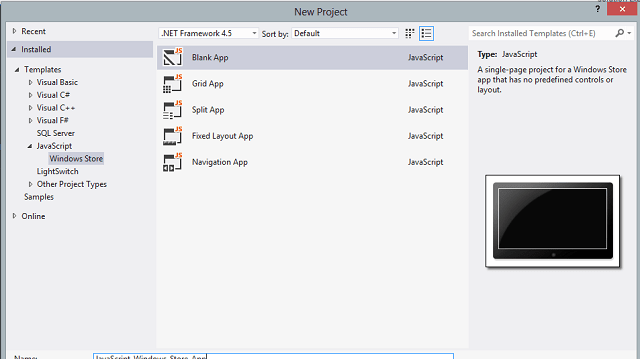
After you created the project, right click “js” folder in Solution Explorer and add a new JavaScript File named “send_email.js”.
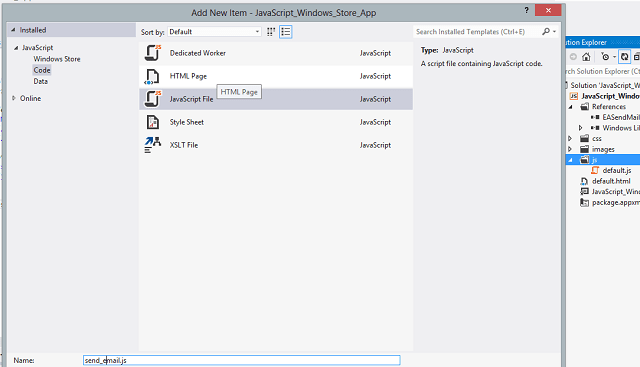
Then include “send_email.js” in default.html and add two input (button) HTML tags and one span HTML tag in default.html like this:
<!DOCTYPE html>
<html>
<head>
<meta charset="utf-8" />
<title>JavaScript_Windows_Store_App</title>
<!-- WinJS references -->
<link href="//Microsoft.WinJS.1.0/css/ui-dark.css" rel="stylesheet" />
<script src="//Microsoft.WinJS.1.0/js/base.js"></script>
<script src="//Microsoft.WinJS.1.0/js/ui.js"></script>
<!-- JavaScript_Windows_Store_App references -->
<link href="/css/default.css" rel="stylesheet" />
<script src="/js/default.js"></script>
<script src="/js/send_email.js"></script>
</head>
<body>
<p>
<input type="button" id="btnSend" value="Send" style="width: 120px;" />
<input type="button" id="btnCancel" value="Cancel" style="width: 120px;" disabled="disabled" />
</p>
<p>
<span id="textStatus"></span>
</p>
</body>
</html>
Installation¶
EASendMail is a SMTP component which supports all operations of SMTP/ESMTP protocols (RFC 821, RFC 822, RFC 2554). It also supports Exchange Web Service (EWS) and WebDAV protocols. Before you can use the following example codes, you should download the EASendMail Installer and install it on your machine at first.
Install from NuGet
You can also install the run-time assembly by NuGet. Run the following command in the NuGet Package Manager Console:
Install-Package EASendMail
Note
If you install it by NuGet, no sample projects are installed, only .NET assembly is installed.
Add Reference¶
To use EASendMail SMTP Component in your Windows Store App/UWP project, the first step is “Add reference
of EASendMail to your project”. Please create/open your project with Visual Studio,
then select menu -> Project -> Add Reference -> Browse -> Browse..., and
select the Installation Path\Lib\[portable/uap]\EASendMail.winmd from local disk, click Open -> OK, the reference will
be added to your project, and you can start to use EASendMail SMTP
Component in your project.
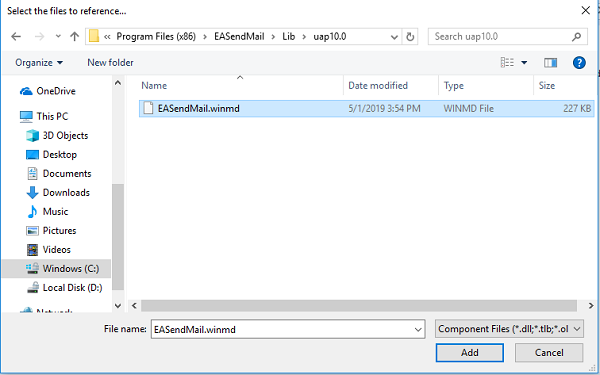
Windows Runtime Assembly¶
After compiling your project, a copy of EASendMail.winmd will be generated by compiler
in same folder of your application executable file. Packing all the *.winmd, *.dll and *.exe
in the folder to installer is ok. As EASendMail.winmd is a pure Windows 8/10 Runtime Component, it doesn’t
require “Regsvr32” (self-register) to register the dll.
| File | .NET Framework Version |
| Lib\portable-win81+wpa81\EASendMail.winmd |
Built with .NET Framework 4.5.1
It requires Windows Store App Runtime 8.1 or later version. |
| Lib\uap10.0\EASendMail.winmd |
Built with Universal Windows Platform.
It requires Windows 10 or later version (Universal Windows Platform). |
[JavaScript - Send email from Windows Store App - HTML5]¶
Now add the following codes to the send_email.js and change From, To, Server, User and
Password to corresponding value and compile your project.
(function () {
"use strict";
var appViewState = Windows.UI.ViewManagement.ApplicationViewState;
var ui = WinJS.UI;
var htmlinited = false;
var editor;
var asynCancel = null;
var m_atts = new Array();
ui.Pages.define("/default.html", {
// This function is called whenever a user navigates to this page. It
// populates the page elements with the app's data.
ready: function (element, options) {
init_gui();
},
unload: function () {
}
});
function init_gui() {
// add OnClick event handler
var btn = document.getElementById("btnSend");
btn.addEventListener("click", send_email, false);
}
function send_email() {
var result = "";
var oMail = new EASendMail.SmtpMail("TryIt");
// Set sender email address, please change it to yours
oMail.from = new EASendMail.MailAddress("test@emailarchitect.net");
// Add recipient email address, please change it to yours
oMail.to.add(new EASendMail.MailAddress("support@emailarchitect.net"));
// Set email subject
oMail.subject = "test email from JavaScript HTML5 project";
// Set email body
oMail.textBody = "this is a test email sent from Windows Store App, do not reply";
// Your SMTP server address
var oServer = new EASendMail.SmtpServer("smtp.emailarchitect.net");
// User and password for ESMTP authentication
oServer.user = "test@emailarchitect.net";
oServer.password = "testpassword";
// If your SMTP server requires TLS connection on 25 port, please add this line
// oServer.connectType = EASendMail.SmtpConnectType.connectSSLAuto;
// If your SMTP server requires SSL connection on 465 port, please add this line
// oServer.port = 465;
// oServer.connectType = EASendMail.SmtpConnectType.connectSSLAuto;
var oSmtp = new EASendMail.SmtpClient();
var btn = document.getElementById("btnSend");
btn.disabled = true;
oSmtp.sendMailAsync(oServer, oMail).then(function (e) {
result = "Email was sent successfully!";
// Display Result by Diaglog box
(new Windows.UI.Popups.MessageDialog(result, "Success")).showAsync();
btn.disabled = false;
},
function (e) {
// because javascript exception only gives the stack trace messages, but it is not
// real description of exception, so we give a property lastErrorMessage for javascript.
if (oSmtp.lastErrorMessage != "") {
result = oSmtp.lastErrorMessage;
}
else {
result = e.message;
}
oSmtp.close();
// Display Result by Diaglog box
(new Windows.UI.Popups.MessageDialog(result, "Error Information")).showAsync();
btn.disabled = false;
});
}
})();
If you set everything right, click the button, you can get “email was sent successfully”. If you get “failed to send email with the following error:”, then please have a look at the following section.
Common SMTP Transport Error¶
When you execute above example code, if it threw an exception about “Networking connection” or “No such host”, it is likely that your SMTP server address is not correct. If it threw an exception about “5xx Relay denied”, it is likely that you did not set user authentication. Another common error is “5xx Must issue a STARTTLS command first” or “No supported authentication marshal found!”, that is because your SMTP server requires user authentication under SSL connection. You can set the SSL connection to solve this problem. You can learn more detail in Troubleshooting section.
Where can I get my SMTP email server address, user and password?¶
Because each email account provider has different server address, so you should query your SMTP server address from your email account provider. To prevent spreading email from the server, most SMTP servers also require user authentication. User name is your email address or your email address without domain part, it depends on your email provider setting.
When you execute above example code, if you get error about “Networking connection” or “No such host”, it is likely that your SMTP server address is not correct. If you get an error like “5xx Relay denied”, it is likely that you did not set user authentication. Another common error is “5xx Must issue a STARTTLS command first” or “No supported authentication marshal found!”, that is because your SMTP server requires user authentication under SSL connection. You can set the SSL connection to solve this problem.
Finally, if you have already set your account in your email client such as Outlook or Window Mail, you can query your SMTP server address, user in your email client. For example, you can choose menu -> “Tools” - > - “Accounts” - > “Your email account” - > “Properties” - > “Servers” in Outlook express or Windows Mail to get your SMTP server, user. Using EASendMail to send email does not require you have email client installed on your machine or MAPI, however you can query your exist email accounts in your email client.
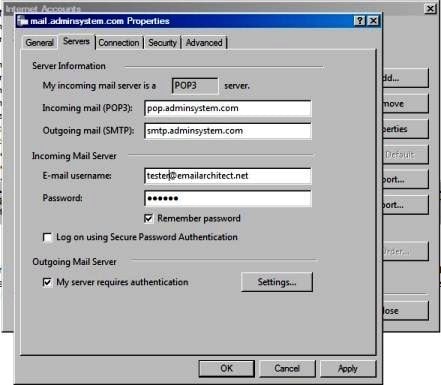
Email Address Syntax and Multiple Recipients¶
Mail Address Syntax in EASendMail SMTP Component:
// For single email address (From, ReplyTo, ReturnPath), the syntax can be:
// ["][display name]["]<email address>
// For example:
"Tester, T" <test@adminsystem.com>
Tester <test@adminsystem.com>
<test@adminsystem.com>
test@adminsystem.com
// For mulitple email address (To, CC, Bcc), the syntax can be:
// [single email],[single email]...
// (,;\r\n) can be used to separate multiple email addresses.
// For example:
"Tester, T" <test1@adminsystem.com>, Tester2 <test2@adminsystem.com>,
<test3@adminsystem.com>, test4@adminsystem.com
[JavaScript - Email syntax]
To better understand the email address syntax, please refer to the following codes.
// From is a MailAddress class.
// The syntax is like this: "test@adminsystem.com" or "Tester<test@adminsystem.com>"
oMail.from = new EASendMail.MailAddress( "Tester", "test@adminsystem.com" );
oMail.from = new EASendMail.MailAddress( "Tester<test@adminsystem.com>");
oMail.from = new EASendMail.MailAddress( "test@adminsystem.com" );
// To, Cc and Bcc is a AddressCollection class,
// Multiple addresses are separated with (,;)
// The syntax is like this: "test@adminsystem.com, test1@adminsystem.com"
// The example code without implicit converting
oMail.to = new EASendMail.AddressCollection( "test1@adminsystem.com, test2@adminsystem.com" );
oMail.to = new EASendMail.AddressCollection( "Test1<test@adminsystem.com>, Test2<test2@adminsystem.com>");
// You can add more recipient by Add method
oMail.to.add( new EASendMail.MailAddress( "tester", "test@adminsystem.com"));
// You can also add carbon copy (CC) or blind carbon copy (BCC) in the email.
oMail.cc.add( new EASendMail.MailAddress( "CC recipient", "cc@adminsystem.com"));
oMail.bcc.add( new EASendMail.MailAddress( "Bcc recipient", "bcc@adminsystem.com"));
From, ReplyTo, Sender and Return-Path¶
From, Reply-To, Sender and Return-Path are common email headers in email message. You should always set From property at first, it is a MUST to identify the email sender. The following table lists the header and corresponding properties:
| Header | Property |
| From | SmtpMail.From |
| Reply-To | SmtpMail.ReplyTo |
| Sender | SmtpMail.Sender |
| Return-Path | SmtpMail.ReturnPath |
From
This property indicates the original email sender. This is what you see as the “FROM” in most mail clients.
Reply-To
This property indicates the reply address. Basically, when the user clicks “reply” in mail client, the Reply-To value should be used as the recpient address of the replied email. If you don’t set this property, the Reply address is same as From address.
Sender
This property indicates the who submit/send the email. When the user received the email, the email client displays: From: “sender address” on behalf of “from address”. If you don’t set this property, the Sender address is same as From address. Sender property is common used by mail listing provider. This property also takes effect to DKIM/DomainKeys signature, if Sender is different with From address, then you should sign DKIM/DomainKeys based on Sender domain instead of From address domain.
Return-Path
This property indicates the delivery notification report address. If you don’t set this property, the Return-Path address is same as From address. This property also takes effect to SPF record, if Return-Path is different with From address, then remote SMTP server checkes SPF record of Return-Path instead of From address.
The following example codes demonstrate how to specify From, Reply-To, Sender and Return-Path in Email. With the following example codes:
- If the email couldn’t be delivered to recipient, a non-delivery report will be sent
to
report@emailarchitect.net. - If the user received the email, the email client will display:
sender@emailarchitect.neton behalf offrom@adminsystem.com. - If the user click “reply”, the replied email will be sent to
reply@adminsystem.com.
oMail.from = "from@adminsystem.com";
oMail.replyTo = new EASendMail.MailAddress( "replyto@@emailarchitect.net" );
oMail.sender = "sender@emailarchitect.net";
oMail.returnPath = "report@emailarchitect.net";
Mail Priority¶
If you want to set Higher or Lower priority to your email, you can use Priority prority
[JavaScript - Mail Priority - Example]
// Set high priority
oMail.priority = EASendMail.MailPriority.high;
Troubleshooting¶
When you send email in above simple C# project, if it threw an exception, please have a look at the following tips:
“No Such Host” exception¶
This error means DNS server cannot resolve SMTP server, you should check if you input correct server address. If your server address is correct, you should check if your DNS server setting is correct.
Common “Networking Connection” Exception¶
This error means there is a problem with networking connection to SMTP server. You can use Windows built-in Telnet command to detect the networking connection.
Using Telnet to detect networking connection to SMTP server¶
Note
Notice: in Windows 2008/Windows 8 or later version, Telnet Client is not installed
by default, you should enable this command in Control Panel -> Programs and
Features -> Turn Windows feature on or off -> have Telnet Client checked.
Under DOS command prompt, input “telnet [serveraddress] [port]”:
telnet mail.emailarchitect.net 25
press enter.
If the networking connection to your SMTP server is good, it should return a message
like 220 .... If it returns Could not open connection to ..., that means the
networking connection to SMTP server is bad, or outbound 25 port is blocked by anti-virus
software, firewall or ISP. Please have a look at the following screenshot:
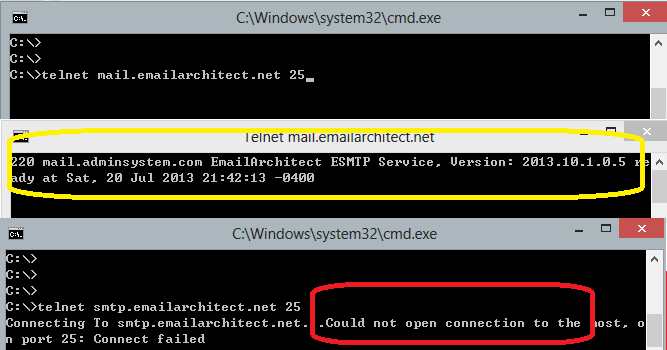
SMTP 25, 587, 465 port¶
25 port is the default SMTP server port to receive email. However, some ISP block outbound 25 port to prevent user to send email directly to other SMTP server. Therefore, many email providers also provide an alternative port 587 to receive email from such users. 465 port is the common port used to receive email over implicit SSL connection. If you use telnet to test 465 port, it doesn’t return the “220…”, because it requires SSL hand shake. But if the connection is ok, telnet returns a flash cursor.
“5xx … IP address block or on black list or bad reputation” Exception¶
This error means SMTP server blocks your IP address or email content. You can try to set user/password in your codes to do user authentication and try it again. If email client set user authentication, most SMTP servers do not check client source IP address in black list.
“5xx user authenticaton” Exception¶
TThis error means user authentication is failed, you should check whether you input correct user/password. Password is always case-sensitive.
“5xx relay denied” Exception¶
For anti-spam policy, most SMTP servers do not accept the email to outbound domain without user authentication. You should set user/password in the codes and try it again.
“5xx Must issue a STARTTLS command first”¶
This error means SMTP server requires SSL/TLS connection. You should enable SSL/TLS connection like this:
// If your smtp server requires TLS connection, please add this line
oServer.connectType = EASendMail.SmtpConnectType.connectSSLAuto;
“No supported authentication marshal found!”¶
This error means SMTP server doesn’t support user authentication or it requires user authentication over SSL/TLS connection. You can try to remove user/password in your codes and try it again.
Other error returned by SMTP server¶
If SMTP server returns an error, it usually returns description about this error. Some descriptions also include a HTTP link, you can go to this linked web page to learn more detail. You can also use the following codes to generate a log file to learn all SMTP session between client and server.
[JavaScript - Using log file to detect SMTP server response - Example]
// add this line here to generate log file
oSmtp.logFileName = "ms-appdata:///local/smtp.txt";
oSmtp.sendMail(oServer, oMail);
Next Section
In this section, I introduced the basic things of sending email in JavaScript with EASendMail. At next section I will introduce how to send email over SSL connection.
Appendix
- EASendMail SMTP Component SDK
- Process Bounced Email (Non-Delivery Report) and Email Tracking
- Bulk Email Sender Guidelines
Comments
If you have any comments or questions about above example codes, please click here to add your comments.
